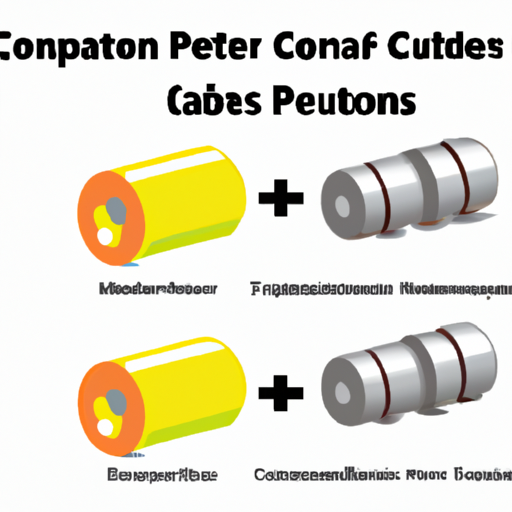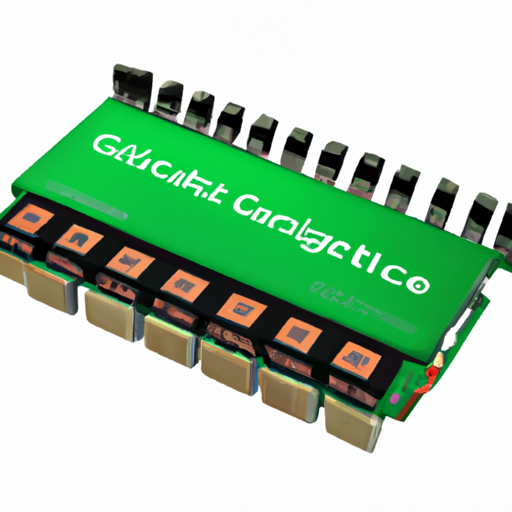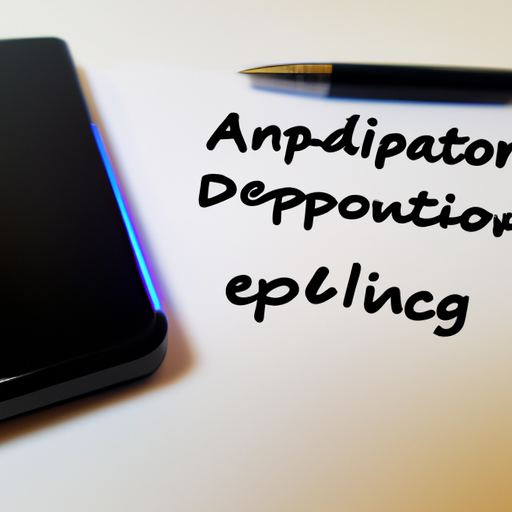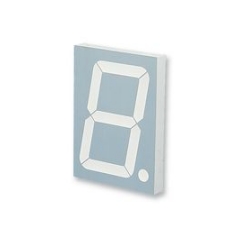What are the common production processes for coupling capacitors?
Common Production Processes for Coupling Capacitors
I. Introduction
A. Definition of Coupling Capacitors
Coupling capacitors are essential components in electronic circuits, designed to allow alternating current (AC) signals to pass while blocking direct current (DC). They serve as a bridge between different stages of a circuit, ensuring that the AC signals can be transmitted without interference from DC components. This functionality is crucial in various applications, including audio equipment, radio frequency circuits, and signal processing systems.
B. Importance of Coupling Capacitors in Electronic Circuits
The role of coupling capacitors cannot be overstated. They help maintain signal integrity by preventing DC bias from one stage of a circuit from affecting another. This is particularly important in amplifiers, where the coupling capacitor ensures that the output signal is a faithful representation of the input signal. Additionally, coupling capacitors can filter out unwanted noise, enhancing the overall performance of electronic devices.
C. Overview of the Production Process
The production of coupling capacitors involves several intricate processes, from material selection to final testing. Understanding these processes is vital for manufacturers aiming to produce high-quality capacitors that meet the demands of modern electronics.
II. Types of Coupling Capacitors
A. Ceramic Capacitors
Ceramic capacitors are widely used for coupling applications due to their small size, low cost, and stable performance. They are made from ceramic materials that exhibit dielectric properties, allowing them to store electrical energy effectively.
B. Film Capacitors
Film capacitors utilize thin plastic films as the dielectric material. They are known for their excellent stability, low loss, and high voltage ratings, making them suitable for various coupling applications, especially in audio and high-frequency circuits.
C. Electrolytic Capacitors
Electrolytic capacitors are polarized components that offer high capacitance values in a compact form. They are often used in power supply circuits but can also serve as coupling capacitors in specific applications where their characteristics are advantageous.
D. Tantalum Capacitors
Tantalum capacitors are known for their high capacitance and reliability. They are often used in compact electronic devices where space is limited. Their stable performance under varying conditions makes them a popular choice for coupling applications.
E. Comparison of Different Types
Each type of coupling capacitor has its advantages and disadvantages. Ceramic capacitors are cost-effective and compact, while film capacitors offer superior performance in high-frequency applications. Electrolytic capacitors provide high capacitance but are limited by their polarity, and tantalum capacitors are reliable but can be more expensive. The choice of capacitor type depends on the specific requirements of the application.
III. Raw Materials Used in Coupling Capacitor Production
A. Dielectric Materials
The dielectric material is a critical component of coupling capacitors, as it determines the capacitor's performance characteristics. Common dielectric materials include ceramic, polyester, polypropylene, and tantalum oxide. The selection of dielectric material is based on factors such as temperature stability, voltage rating, and capacitance value.
1. Characteristics and Selection Criteria
When selecting dielectric materials, manufacturers consider factors like dielectric constant, loss tangent, temperature coefficient, and mechanical strength. These characteristics influence the capacitor's performance in various applications.
B. Conductive Materials
Conductive materials are used for the electrodes of coupling capacitors. Commonly used conductors include aluminum, copper, and silver. The choice of conductive material affects the capacitor's efficiency and overall performance.
1. Types of Conductors Used
Aluminum is often used in electrolytic capacitors due to its lightweight and cost-effectiveness. Copper is favored for its excellent conductivity, while silver, though more expensive, is used in high-performance applications.
C. Packaging Materials
The packaging of coupling capacitors is crucial for protecting the internal components and ensuring reliable performance. Packaging materials must be durable and capable of withstanding environmental factors such as humidity and temperature fluctuations.
1. Importance of Packaging in Capacitor Performance
Proper packaging not only protects the capacitor but also influences its thermal management and electrical performance. Manufacturers must choose packaging materials that complement the capacitor's design and intended application.
IV. Common Production Processes
A. Material Preparation
The production of coupling capacitors begins with material preparation. This involves sourcing high-quality raw materials and conducting rigorous quality control to ensure that they meet the required specifications.
1. Sourcing and Quality Control
Manufacturers often establish relationships with trusted suppliers to ensure a consistent supply of quality materials. Quality control measures, such as testing and inspection, are implemented to verify the integrity of the materials before production.
2. Material Processing Techniques
Once the materials are sourced, they undergo various processing techniques, including grinding, mixing, and coating, to prepare them for capacitor production.
B. Dielectric Layer Formation
The dielectric layer is a crucial component of coupling capacitors, and its formation varies depending on the type of capacitor being produced.
1. Techniques for Different Capacitor Types
a. Ceramic Layer Formation
For ceramic capacitors, the dielectric layer is formed by pressing and sintering ceramic powders at high temperatures. This process creates a dense, stable dielectric material.
b. Film Layer Deposition
Film capacitors utilize techniques such as extrusion or vapor deposition to create thin layers of dielectric material. These methods ensure uniform thickness and high-quality dielectric properties.
c. Electrolytic Layer Formation
In electrolytic capacitors, the dielectric layer is formed through an electrochemical process, where a thin oxide layer is created on the surface of the anode material.
C. Electrode Fabrication
The electrodes of coupling capacitors are critical for their performance. The fabrication process involves several methods to ensure high-quality electrodes.
1. Methods of Electrode Production
Electrodes can be produced through techniques such as sputtering, chemical vapor deposition, or physical vapor deposition. Each method has its advantages, depending on the desired properties of the electrodes.
2. Importance of Electrode Quality
The quality of the electrodes directly impacts the capacitor's performance, including its capacitance, voltage rating, and reliability. Manufacturers must ensure that the electrodes are free from defects and meet the required specifications.
D. Assembly Process
The assembly process involves combining the dielectric and electrode layers to create the final capacitor.
1. Layer Stacking and Alignment
In this stage, the dielectric and electrode layers are carefully stacked and aligned to ensure optimal performance. Precision is crucial, as misalignment can lead to reduced capacitance and increased leakage current.
2. Encapsulation Techniques
Once assembled, the capacitors are encapsulated to protect them from environmental factors. Common encapsulation techniques include resin coating and plastic molding, which provide durability and reliability.
E. Testing and Quality Assurance
Quality assurance is a critical aspect of capacitor production. Manufacturers conduct various tests to ensure that the capacitors meet performance standards.
1. Electrical Testing
Electrical testing involves measuring parameters such as capacitance, equivalent series resistance (ESR), and leakage current. These tests help verify that the capacitors function as intended.
2. Environmental Testing
Environmental testing assesses the capacitors' performance under different conditions, including temperature and humidity variations. This ensures that the capacitors can withstand real-world operating conditions.
3. Reliability Testing
Reliability testing involves subjecting capacitors to stress tests to evaluate their long-term performance and durability. This helps identify potential failure modes and ensures that the capacitors will perform reliably over their intended lifespan.
V. Advanced Manufacturing Techniques
A. Automation in Capacitor Production
Automation plays a significant role in modern capacitor production, enhancing efficiency and consistency. Automated processes reduce human error and increase production speed, allowing manufacturers to meet growing demand.
B. Use of Computer-Aided Design (CAD) and Simulation
Computer-aided design (CAD) and simulation tools are increasingly used in capacitor design and production. These tools enable manufacturers to optimize designs, predict performance, and streamline the production process.
C. Innovations in Material Science
Advancements in material science are driving the development of new dielectric and conductive materials, leading to improved capacitor performance. Researchers are exploring novel materials that offer higher capacitance, lower losses, and better thermal stability.
D. Sustainable Manufacturing Practices
Sustainability is becoming a priority in capacitor production. Manufacturers are adopting eco-friendly practices, such as reducing waste, recycling materials, and using sustainable energy sources, to minimize their environmental impact.
VI. Challenges in Coupling Capacitor Production
A. Material Sourcing Issues
Sourcing high-quality materials can be challenging, especially in a global market where supply chain disruptions can occur. Manufacturers must establish reliable supply chains to ensure consistent production.
B. Quality Control Challenges
Maintaining quality control throughout the production process is essential. Manufacturers face challenges in detecting defects and ensuring that all components meet stringent quality standards.
C. Environmental Regulations
Compliance with environmental regulations is becoming increasingly important. Manufacturers must navigate complex regulations related to material sourcing, waste disposal, and emissions, which can impact production costs and processes.
D. Market Demand Fluctuations
The demand for coupling capacitors can fluctuate based on market trends and technological advancements. Manufacturers must be agile and responsive to changing market conditions to remain competitive.
VII. Future Trends in Coupling Capacitor Production
A. Emerging Technologies
Emerging technologies, such as 5G and Internet of Things (IoT), are driving demand for advanced coupling capacitors. Manufacturers must adapt to these trends by developing capacitors that meet the specific requirements of new applications.
B. Market Predictions
The global capacitor market is expected to grow significantly in the coming years, driven by the increasing demand for electronic devices and renewable energy solutions. Manufacturers must position themselves to capitalize on this growth.
C. Impact of Electric Vehicles and Renewable Energy
The rise of electric vehicles and renewable energy sources is creating new opportunities for coupling capacitors. Manufacturers must innovate to develop capacitors that can handle the unique challenges posed by these applications.
VIII. Conclusion
A. Summary of Key Points
Coupling capacitors play a vital role in electronic circuits, and their production involves a complex interplay of materials, processes, and quality control measures. Understanding these processes is essential for manufacturers aiming to produce high-quality capacitors.
B. The Importance of Continuous Improvement in Production Processes
As technology evolves, so too must the production processes for coupling capacitors. Continuous improvement is essential to meet the demands of modern electronics and ensure that capacitors perform reliably in various applications.
C. Final Thoughts on the Future of Coupling Capacitors
The future of coupling capacitors is bright, with emerging technologies and growing market demand driving innovation. Manufacturers who embrace advanced manufacturing techniques and sustainable practices will be well-positioned to thrive in this dynamic industry. As the world becomes increasingly reliant on electronic devices, the importance of high-quality coupling capacitors will only continue to grow.







